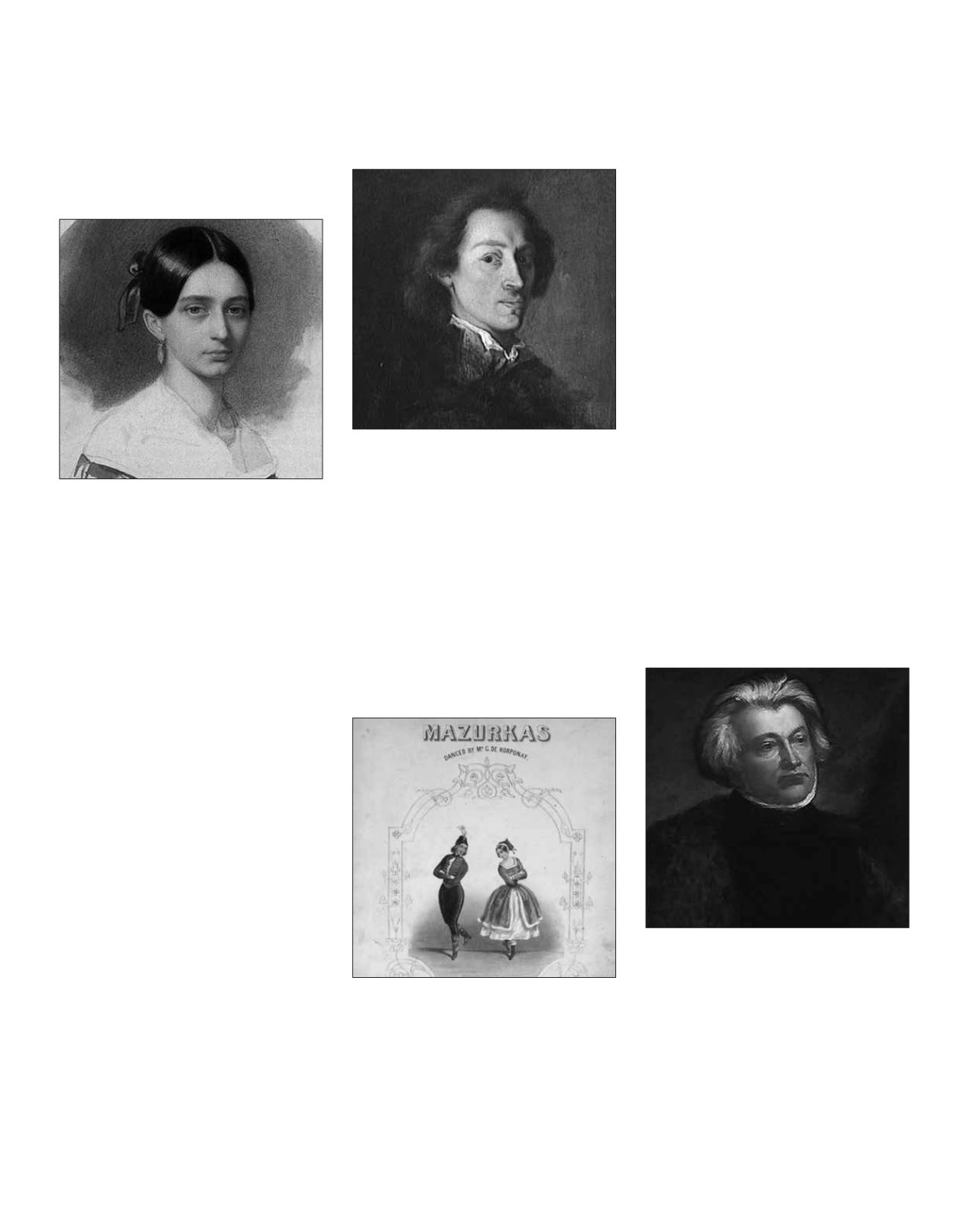
former piano teacher, firmly opposed the mar-
riage and tried all means to prevent the union.
The protective father attempted to separate
the lovers by whisking Clara away on a sev-
en-month concert tour. Eventually the case was
taken to court, where Wieck accused Schumann
of financial instability and over-consumption.
In the end, the court ruled in favor of Robert
and Clara, who married in 1840.
Emotional turmoil surrounding the legal battles
and extended periods of separation from Clara
stirred Schumann’s creativity. He composed the
set of piano pieces known as
Kreisleriana
in 1838
during Clara’s absence. The title is derived from
an essay of the same name in E.T.A. Hoffmann’s
novel
Fantasiestücke in Callots Manier
. The main
protagonist was Johannes Kreisler, an artist tor-
mented by the public’s failure to recognize his
talent. Kreisler (Hoffmann’s alter ego) has a
companion in the tomcat Murr, who in
Kater
Murr
unsuccessfully attempts to enter poodle
society. In the end, Kreisler and Murr find ac-
ceptance only in seclusion.
The Romantic concept of the unappreciated,
misunderstood artist appealed to Schumann,
particularly at a time when his own integri-
ty came into question. In his critical essays,
Schumann invented the fictitious personas Eu-
sebius and Florestan to reveal the opposing sides
of his Romantic nature. The eight works that
form
Kreisleriana
, subtitled “Fantasies for Pia-
no” and dedicated to Chopin, are divided into
several sections of contrasting character that re-
flect Schumann’s varying states of mind.
FRYDERYK FRANCISZEK CHOPIN (1810–49)
Fourteen Mazurkas
Franz Liszt devoted one entire chapter in his
Chopin biography to a description of his friend’s
artistic transformation of the Polish peasant
dance form—the mazurka. “Chopin released
the poetic
unknown
which was only suggested
in the original themes of Polish
mazurkas
. He
preserved the rhythm, ennobled the melody, en-
larged the proportions, and infused a harmonic
chiaroscuro as novel as the subjects it support-
ed—all this in order to paint in these produc-
tions (which he loved to hear us call
easel pic-
tures
) the innumerable and so widely differing
emotions that excite the heart while the dance
goes on.”
Even before Liszt’s 1852 biography, audiences
and musicians overwhelmingly viewed Chopin’s
mazurkas as miniature keyboard portraits. In
his supreme hands, the mazurka’s utter simplic-
ity of form (traditionally, three parts in which
the first and last share a common theme) and
substance (three beats per measure, often with
a dotted rhythm on the first beat and special
emphasis on beat two) evolved into a Romantic
poetic medium penetrating to the “unknown”
recesses of the soul. This inward quality con-
trasted with the polonaise, another dance genre
mastered by Chopin, which reflected a more ex-
troverted side of the Polish identity.
The mazurka originated in the region surround-
ing Warsaw among the people known as the Ma-
zurs. The musical characteristics of the mazurka
served as the basis for both peasant dances and
folk songs. Chopin was the first great composer
to devote himself to the refinement of this folk
form. His nearly 60 mazurkas embodied a wide
variety of sentiments, which Liszt categorized
as “flirtations, conceits, fancies, attachments,
laments, passions developed and awakening,
and conquests on which may depend another’s
fate or fervor.” Typically, Chopin’s mazurkas
follow a straightforward three-part design. Like
their folk predecessors, these piano miniatures
vary greatly in character and atmosphere.
Ballade No. 3 in A-flat major, op. 47
Poetry expressed through sound became the
Romantic musician’s obsession. Some indi-
viduals linked their compositions to a written
program, outlining—often in literal fashion—
associations between themes and words. Other
composers created miniature character sketch-
es. Another group of rare artists sought a deeper
and subtler “musical poeticism” that penetrated
the listener’s soul and loosened his imagination.
Chopin—especially in the nocturnes, impromp-
tus, scherzos, and ballades—fell into the last
category.
Many writers, among them Charles Rosen,
consider the four ballades “perhaps Chopin’s
greatest achievement.” In his union of operatic
lyricism with a narrative sequence of themes, he
“realized in music one of the major ambitions
of the Romantic poets and novelists,” observed
Rosen. Chopin allegedly drew inspiration for his
music from ballade poems about placid lake wa-
ters and delicate nymphs by Adam Mickiewicz,
a fellow Pole. Some recent scholars even have
discerned poetic meters in their long–short mu-
sical rhythms.
Chopin toiled long and hard over the composi-
tion of his first two ballades, but the third took
shape relatively quickly during the summer of
1841. Initially, the Ballade No. 3 in A-flat major,
op. 47, creates an almost matter-of-fact impres-
sion. This, however, is sheer deception: Chopin
imperceptibly refashions his simplistic melod-
ic ideas and aimless harmonic motion into a
grand crescendo toward a passionate bravura
conclusion.
–Program notes © 2018 Todd E. Sullivan
Clara Wieck
Fryderyk Franciszek Chopin, by Ary Sheffer
Lithograph of four mazurkas (1844–50) danced by
Mr. G. De Korponay
Adam Mickiewicz
RAVINIA MAGAZINE | JUNE 1 – JUNE 10, 2018
106








